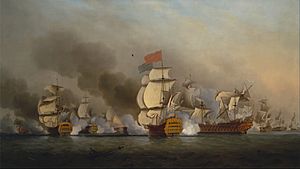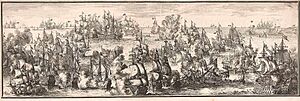First Battle of Cape Finisterre (1747) facts for kids
Quick facts for kids First Battle of Cape Finisterre |
|||||||
|---|---|---|---|---|---|---|---|
| Part of the War of the Austrian Succession | |||||||
 Lord Anson's victory off Cape Finisterre, Samuel Scott |
|||||||
|
|||||||
| Belligerents | |||||||
| Commanders and leaders | |||||||
| Strength | |||||||
| 14 ships of the line 1 frigate 1 sloop 1 fireship |
4 ships of the line 8 frigates 4 corvettes 30 merchant ships |
||||||
| Casualties and losses | |||||||
| 520 killed and wounded | 800 killed and wounded 3,000 captured 4 ships of the line captured 4 frigates captured 4 corvettes captured 6 merchantmen captured |
||||||
The First Battle of Cape Finisterre happened on May 14, 1747. It was a big naval fight during the War of the Austrian Succession. This battle took place in the Atlantic Ocean near Cape Finisterre in northwest Spain.
It was a clash between the British Navy and the French Navy. The British fleet, led by Admiral George Anson, had 14 large warships called ships of the line. They attacked a French group of 30 ships, which included merchant ships protected by warships. The French group was commanded by Admiral de la Jonquière.
The battle lasted about five hours. The British won, capturing several French warships and merchant ships. This victory was important for the British during the war.
Contents
What Happened at the Battle?
Before the Fight: Setting Sail
France needed to keep its sea routes open to connect with its colonies overseas. To do this, they gathered merchant ships into groups called convoys. These convoys were protected by warships.
Meanwhile, British Admirals George Anson and Sir Peter Warren set sail from Plymouth, England. Their goal was to stop French ships. On April 9, they left port on their ships, Prince George and Devonshire.
One day, they spotted a large French convoy. Admiral Anson first ordered his ships to form a battle line. But Admiral Warren thought the French were trying to help their merchant ships escape. So, he told Anson, and Anson quickly ordered a general chase. This meant all British ships should go after the enemy as fast as possible.
The Battle Begins
The British ship Centurion was the fastest. It was the first to reach the last French ship. The Centurion attacked fiercely. Two other French ships came back to help their friend.
Soon, more British ships joined the fight. These included the Devonshire. Even though the French had fewer warships, they fought bravely. The battle continued until seven in the evening.
In the end, almost all the French warships were captured. Nine French merchant ships, which belonged to the French East India Company, were also taken. The French lost about 700 men killed or wounded. The British lost 520. The British also found a lot of money, over £300,000, on the captured French warships. These captured ships were then added to the British fleet.
A young French officer named François de Grasse was wounded in this battle. He later became a very famous admiral. He was captured along with his crew on the ship La Gloire.
After the Battle: British Victory
After this important win, Admiral Anson was given a special honor. He was made a peer, which meant he became a Lord.
The French tried again to send a large convoy in October of the same year. But the British, led by Edward Hawke, defeated this new fleet in the Second Battle of Cape Finisterre. After these two defeats, France stopped its naval operations for the rest of the war.
An American historian named William Williamson wrote about this battle in 1832. He said it was a "most severe blow" to French interests in America. He noted that besides the valuable goods captured, the ships also carried many items meant for the Acadians and Native Americans.
Images for kids
See also




